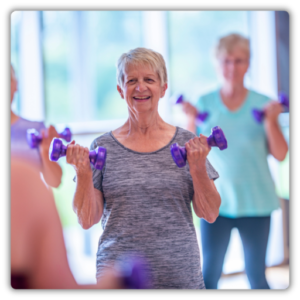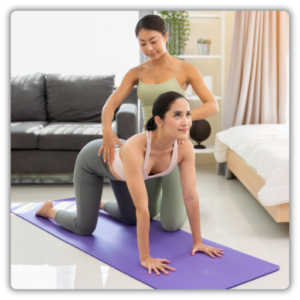 As women age, especially after 50, maintaining a healthy weight becomes increasingly important yet challenging. Hormonal changes, muscle mass loss, and lifestyle shifts can lead to weight gain. In this section, we explore the best ways to lose weight after 50, focusing on effective exercise tips tailored for women to enhance their weight loss journey.
As women age, especially after 50, maintaining a healthy weight becomes increasingly important yet challenging. Hormonal changes, muscle mass loss, and lifestyle shifts can lead to weight gain. In this section, we explore the best ways to lose weight after 50, focusing on effective exercise tips tailored for women to enhance their weight loss journey.
KEY POINTS
- Strength Training for Muscle Preservation – Incorporating strength training exercises, like weightlifting and resistance band workouts, helps women over 50 maintain muscle mass, which naturally decreases with age. Building muscle boosts metabolism, aiding in calorie burning and overall weight loss.
- Cardio for Heart Health and Calorie Burn – Aerobic exercises such as walking, jogging, and swimming effectively burn calories and promote cardiovascular health. Engaging in moderate to vigorous cardio for at least 150 minutes per week can enhance weight loss and reduce the risk of metabolic syndrome.
- Flexibility and Balance Exercises for Mobility – Incorporating activities like yoga and Pilates improves flexibility, balance, and joint mobility, which are essential for healthy aging. These exercises help prevent injuries and enhance daily functional movements, making it easier to stay active.
- Balanced Diet and Lifestyle Adjustments – Pairing regular exercise with a nutrient-rich diet, including high-protein foods, fruits, and vegetables, supports muscle preservation and energy levels. Reducing processed foods, sugar intake, and ensuring adequate sleep contribute to a more sustainable weight loss journey after 50.

Pop in your email below, and we’ll zip it straight to your inbox so you never lose it!
How Can Women Over 50 Effectively Exercise to Lose Weight?
Women over 50 can effectively exercise to lose weight by incorporating weight training and resistance bands into their exercise program. This helps to maintain muscle mass as muscle mass decreases with age, reducing body fat percentage and the effects of exercise on heart disease and type 2 diabetes.
Aim for three days a week of strength training, complemented by yoga and pilates for flexibility and range of motion. Exercise not only burns calories but also helps to lower cholesterol and high blood pressure, reducing the risk of developing metabolic syndrome.
Research shows that healthy eating, including legumes and brown rice, combined with regular exercise, can help postmenopausal women manage excess weight and hot flashes. A registered dietitian can help keep you accountable to your goals, making it never too late to start.
Looking to take control of your weight & nutrition?

What Types of Exercise Help You Lose Weight After 50?
 Losing weight after age 50 can be challenging due to natural changes in metabolism, muscle mass, and hormone levels. A balanced fitness routine incorporating different types of exercises can support weight loss, improve overall health, and counteract age-related muscle and bone loss. Here are some effective exercise types and tips for weight loss and health after 50:
Losing weight after age 50 can be challenging due to natural changes in metabolism, muscle mass, and hormone levels. A balanced fitness routine incorporating different types of exercises can support weight loss, improve overall health, and counteract age-related muscle and bone loss. Here are some effective exercise types and tips for weight loss and health after 50:
- Strength Training
- Why: Building muscle helps boost metabolism and counteracts the natural muscle loss that occurs with age. Increased muscle mass helps burn more calories, even at rest.
- How: Aim for at least two sessions per week using weights, resistance bands, or bodyweight exercises like squats and push-ups. Focus on exercises targeting all major muscle groups.
- Aerobic Exercise (Cardio)
- Why: Cardiovascular activities like brisk walking, jogging, or swimming help burn calories and improve heart health.
- How: Try for at least 150 minutes per week of moderate-intensity cardio, or 75 minutes of vigorous cardio, such as cycling or running.
- High-Intensity Interval Training (HIIT)
- Why: HIIT involves short bursts of intense exercise followed by rest periods, which is effective for fat burning and can improve endurance.
- How: Try incorporating HIIT workouts 1-2 times per week with exercises like sprint intervals, jump squats, or cycling intervals for 20-30 minutes.
- Bodyweight Exercises
- Why: Exercises using your own body weight, like lunges, planks, and push-ups, help build strength and flexibility without equipment, which is ideal for home workouts.
- How: Include bodyweight exercises in your routine to build muscle, improve stability, and enhance mobility.
- Flexibility and Balance Training
- Why: Flexibility exercises, such as yoga or Pilates, help improve joint mobility, reduce injury risk, and enhance balance, which is essential as we age.
- How: Dedicate at least 10-15 minutes per day to stretching or try a yoga or Pilates class once a week.
- Functional Movement Exercises
- Why: Functional exercises, such as squats, lunges, and single-leg movements, mimic daily activities, helping improve balance and coordination for everyday tasks.
- How: Add these movements to your strength training routine to improve overall mobility and prevent falls.
How Does Strength Training Benefit Women Over 50?
Research shows that strength training is one of the best ways for postmenopausal women to combat the effects of exercise as they get older. Engaging in weight training or using resistance bands at least three days a week can help maintain muscle mass and counteract muscle loss, which tends to occur after age 50.
In addition to preserving muscle mass, strength training can help lower body fat percentage and reduce the risk of high blood pressure, heart disease, and type 2 diabetes. Research suggests that an effective exercise program combined with healthy eating can help control cholesterol levels and mitigate metabolic syndrome.
For women seeking a manageable way to stay active, even brisk walking can be incredibly beneficial. Try this 30-minute weight loss walking workout specifically designed for women over 50.
Incorporating a mix of stretching exercises, yoga and pilates, and aerobic activities like jogging can enhance bone strength and improve range of motion. As a registered dietitian might advise, balancing burns more calories than fat and fewer calories from processed foods, such as brown rice and legumes, can help keep you accountable in your health journey.
What Aerobic Exercises Are Best for Weight Loss?
 When it comes to weight loss, aerobic exercises are crucial as they help burn many calories. Activities like running, cycling, and swimming are packed with calories burned, making them effective. However, it’s important to maintain a balance to avoid losing muscle mass, ensuring you carry on a conversation during workouts.
When it comes to weight loss, aerobic exercises are crucial as they help burn many calories. Activities like running, cycling, and swimming are packed with calories burned, making them effective. However, it’s important to maintain a balance to avoid losing muscle mass, ensuring you carry on a conversation during workouts.
Engaging in aerobic activities at a moderate intensity is likely to lose excess weight while promoting physiological health. Staying informed about your privacy policy and terms can enhance your exercise experience, as well as being aware of the policy and terms of service of any fitness programs you use.
Incorporating regular aerobic exercise is important for overall fitness and well-being, supporting a healthy lifestyle while effectively managing weight.
How Do Hormonal Changes Affect Weight After 50?
What Is the Impact of Menopause on Body Composition?
The impact of menopause on body composition often complicates weight management due to hormonal changes. To counteract this, incorporating resistance training can enhance muscle mass, which is crucial for a healthy body. Additionally, increasing protein intake alongside a diet rich in fruits and vegetables supports weight loss efforts.
Experts suggest focusing on these lifestyle changes to mitigate menopause effects. Following their expert tips can lead to more effective weight loss efforts, fostering better overall health during this transitional phase.
How Can You Combat Weight Gain During Menopause?
To effectively combat weight gain during menopause, focus on weight management through a balanced approach. Incorporate resistance training to build muscle and boost metabolism, which aids in your weight loss efforts.
Enhance your diet by increasing fruits and vegetables, while also prioritizing adequate protein intake for a healthy body. Follow expert tips to navigate this transformative phase with confidence.
What Are the Best Ways to Manage Weight Gain After Age 50?
 Managing weight gain after age 50 involves a combination of healthy choices. Regular physical activity is crucial; aim for at least 150 minutes of moderate exercise weekly to boost metabolism.
Managing weight gain after age 50 involves a combination of healthy choices. Regular physical activity is crucial; aim for at least 150 minutes of moderate exercise weekly to boost metabolism.
Additionally, monitoring diet can help combat belly fat, focusing on whole foods and reducing sugar intake to maintain a healthy weight.
How Can You Prevent Loss of Muscle Mass?
To prevent loss of muscle mass, focus on a balanced diet and exercise regimen. Incorporating strength training into your routine can help maintain muscle strength.
Additionally, create a sustainable eating plan rich in protein, healthy fats, and complex carbohydrates to support muscle recovery and growth.
How Does Age Affect Weight Loss Success?
Age significantly influences weight loss success, as metabolic rates typically decline with increasing years. Older adults may face challenges such as hormone changes and muscle loss, which can hinder fat loss.
Additionally, lifestyle factors and activity levels often change, making it harder to maintain a calorie deficit. Understanding these dynamics is crucial for tailored weight loss strategies.
What Changes in Metabolism Should You Expect?
Metabolism undergoes various changes with age, leading to a decrease in basal metabolic rate. This can result in weight gain if caloric intake remains unchanged.
Additionally, hormonal shifts can affect how your body processes nutrients, often leading to increased fat storage and decreased muscle mass over time.
Regular exercise and a balanced diet can help mitigate these changes, promoting a healthier metabolic function.
For a deeper dive into weight loss strategies tailored for women over 50, explore these effective ways to lose weight after 50 from Medical News Today.











